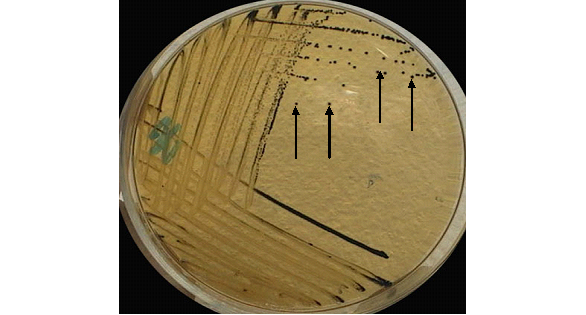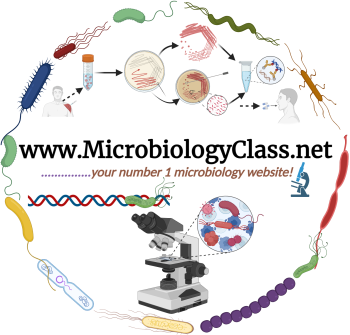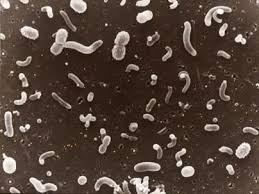Salmonella Typhi is a Gram-negative, non-lactose fermenting and facultative straight rod found in the genus Salmonella and family Enterobacteriaceae. Most Salmonella (e.g. Salmonella Typhimurium) are motile in nature, and they move by means of their flagella. Salmonella species inhabit the intestinal tracts of warm blooded and cold blooded animals (where they can be important pathogens), and they cause a range of infections in humans especially food borne infections and enteric febrile infections. Salmonella Typhi (as it is properly written) is the main causative agent of typhoid fever in humans. Other species of Salmonella such as S. Typhimurium and S. Paratyphi are mainly responsible for causing gastrointestinal infections and paratyphoid febrile infections respectively in man.
Not all Salmonella strains are typhoid-causing as some species are non-typhoid strains and rarely cause bacteraemia or other human infections. About 200 serovars of Salmonella species are known to exist, and these are classified based on the antigenic structure of the organism i.e. on their cell wall antigens (O antigens) and flagellar antigens (H antigens). Basically, the species of Salmonella are usually characterized in the microbiology laboratory by serodiagnosis on the basis of the three major kinds of antigens that this group of bacteria expresses. The three types of antigens expressed by Salmonella species, and which aids in their laboratory diagnosis by serological techniques are:
- O antigens (somatic cell wall antigens).
- H antigens (flagellar antigens).
- V or K antigens (capsular or surface antigens)
The virulence and pathogenicity of Salmonella is usually enhanced in vivo by a number of virulence factors which they express. Enterotoxins, cytotoxins and a number of lipopolysaccharides (LPS) antigens as well as the above stated antigens are some of the virulence factors used by the pathogen to initiate infection in human hosts. Salmonella species are found in the environment (e.g. in the soil and water) when humans and animals (that are the natural host of the parasite) excrete them in their feaces especially indiscriminately in a way that contaminates the soil and water.
Human infection with Salmonella species (especially the S. Typhi and S. Typhimurium serovars) normally occurs via the consumption of food and water contaminated with the pathogen, and transmission of the organism is through the feacal-oral route. The nomenclature of Salmonella does not concur with the normal classification scheme for other bacteria because the binomials of the organism refer to serotypes or serovars rather than to species as is obtainable with other bacterial cells. Salmonella bacteria are a continuum of organisms rather than a defined species of bacteria, and this amongst other factors has led to some hitches associated with its classification.
For example, the actual name for “Salmonella typhimurium”is Salmonella enterica serotype Typhimurium but the former though incorrect is still widely used. Salmonella enterica serotype Typhimurium could be shortened and written as Salmonella Typhimurium which is the correct name. It could be observed that only the generic name is in italics, and this is how it should be for other serovars of Salmonella. Serotype names should not be italicized since they emanate from a subspecies of a genus and species (in this case Salmonella enterica subspecies). This also applies to Salmonella typhi which is also written as a genus and species. The correct way to write “Salmonella typhi” is Salmonella Typhi with the genus name in italics and the serotype name in roman type (i.e. it should not be italicized).
Current nucleic acid studies based on DNA-DNA hybridization techniques have recognized seven groups or subgroups of Salmonella, and they aredesignated as enterica I, salamae II, arizonae IIIa, diarizonae IIIb, houtenae IV, bongori V and indica VI serogroups. Clinicallyimportant Salmonella species are usually found in the enterica I subgroup. Each of this subspecies contains various serovars or serotypes with distinct antigenic formulars. Salmonella species that cause human infections (including S. Typhi, S. Typhimurium and S. Paratyphi A, B & C) are classified under the subgroup I (i.e. enterica I), and they can generally be referred to as subspecies of S. enterica.
In summary, all Salmonellae are classified under the S. enterica species (that comprises seven serovars as shown above), and the serovars of Salmonellae (which are determined by specific slide agglutination tests based on the O and H antigens of the pathogen) are all written in capitalized format in order to differentiate them from species of Salmonella. Salmonella parasitize a wide range of living organisms including humans, amphibians, birds, pets, cattle, rodents and other mammals but only those that cause human infections (i.e. the S. Typhi and S. Paratyphi A, B & C serovars) shall be expanded in this section. They can also be found in low-moisture food products such as nuts, pepper, spices and peanuts, and these could serve as medium via which the pathogen is transmitted to humans.
PATHOGENESIS OF SALMONELLA INFECTION
Healthy individuals are less prone to Salmonella infections due to their intact immune system and practice of good personal hygiene. The immunocompromised, infants and the elderly are more at risk of becoming infected by Salmonella. Both S. Typhi and S. Paratyphi A, B & C serovars or serotypes are reserved in human hosts and they have no animal reservoirs. Human infection with S. Typhi and S. Paratyphi is via the oral-route, and this is mainly contracted through an already infected individual. Generally, febrile infections known as typhoid fever and caused by S. Typhi only occur in human when a large dose of Salmonella (e.g. 108 bacteria) has been ingested via contaminated water or hands. While S. Typhi is mainly water-borne, S. Paratyphoid (which causes a lesser febrile infection) is food-borne. After ingestion, Salmonella penetrates the small intestine and multiplies in the lymph nodes or intestinal lymphoid tissues without causing any serious clinical damage.
The release of Salmonella into lymphatic vessels or bloodstream of the human host leads to bacteraemia or septicaemia and other associated infections. The carriage of Salmonella in the bloodstream may also affect other vital organs of the body such as the spleen, liver and the heart. Salmonella is toxigenic and thus releases endotoxin which increases its virulence in the affected human host. Usually, headache, prolonged fever, constipation (in some cases) and malaise may ensue following an infection with S. Typhi and Paratyphi. Infected human hosts release large amounts of S. Typhi in their feaces during the infective stage, and some treated individuals can remain asymptomatic and continue to shed the pathogen in their feaces.
Asymptomatic carriers of Salmonella species are highly infectious because they can remain undetected for a long period of time spanning into years during which they may have transmitted the pathogen to susceptible human hosts. Salmonella Typhimurium serovar is the main causative agent of food-borne Salmonella infection otherwise known as Salmonella gastroenteritis or enterocolitis. Salmonella gastroenteritis is a food-poisoning and diarrheal disease typically prevalent in developed countries (although it occurs in developing countries with varying frequency) due to their cultural engagement in picnic and other outdoor activities.
It is a limiting Salmonella infection, and can disappear after several days of infection even without prior antibiotic therapy. Cooked food especially salads and vegetables can serve as proper culture media for the propagation and transmission of Salmonella to human hosts, and this usually occurs when food contaminated with the pathogen is eaten. Salmonella Typhimurium is reserved in animals unlike S. Typhi (that only inhabit humans), and it can be transmitted from poultry products, diary and meat products to humans. S. Typhimurium occurs in the intestinal tract of birds and other animals including humans. Human infection with S. Typhimurium occurs via the consumption of contaminated egg, water, food, meat and other poultry or dairy products containing large amount of viable Salmonella Typhimurium serovar (105).
Following invasion, S. Typhimurium enters the large and small intestine where they proliferate and cause inflammatory reactions that result is a diarrheal-like disease. The production of enterotoxin and cytotoxin by S. Typhimurium also aids in the pathogenesis and/or virulence of the pathogen in human hosts. Poor handling of food by food processing industries and food handlers can help S. Typhimurium to enter the food supply chain from where human infection ensues. Some of the symptoms of Salmonella gastroenteritis include diarrhea, fever, abdominal cramp, nausea, headache and vomiting and the passing out of loose-bloody feaces (which is merely occasional). The mode of transmission of S. Typhimurium is via the feacal-oral route. Vegetables and other food products should not be washed with feacal-contaminated water, and people should endeavour to eat only well cooked and pasteurized food and milk products.
LABORATORY DIAGNOSIS OF SALMONELLA INFECTION
The laboratory diagnosis of Salmonella infection is mainly based on the isolation and identification of the pathogen from clinically important specimen through cultural techniques. Serological tests based on agglutination methods can also be used for diagnosis of Salmonella infection. Feacal samples, blood, urine and the contaminated food sample are usually requested for laboratory analysis when Salmonella infection is suspected.
Blood and feacal culture are routinely used in some quarters for the laboratory diagnosis of infections caused by Salmonella. Salmonella grow on eosin methylene blue (EMB) agar (producing colourless colonies), MacConkey agar (producing non-lactose fermenting and pale colonies), Salmonella-Shigella (SS) agar (producing pink-red colonies), xylose-lisine-deoxycholate (XLD) agar (producing pink-red colonies with H2S production in some serotypes) and Hektoen enteric (HE) agar (producing blue-green colonies with H2S production).
Salmonella can also be identified in the laboratory by carrying out a number of biochemical tests such as culturing the bacteria in triple sugar iron agar (TSIA) or Kligler iron agar (KIA) medium as well as in other biochemical reagents which are commercially available. Note: Hydrogen sulphide (H2S) production by bacteria including Salmonella is normally indicated by blackish deposits in or around the bacteria colonies growing on culture media especially Salmonella-Shigella agar (SSA) which is used for the selective cultivation of Salmonella species from stool specimens (Figure 1).

IMMUNITY TO SALMONELLA INFECTION
Infection with Salmonella only confers a milder form of immunity in infected human hosts, and a re-infection can occur in individuals who are predisposed to the pathogen or its source of transmission. However, protection against Salmonella infection usually follows a natural infection with the serovars of the pathogen.
TREATMENT OF SALMONELLA INFECTION
The antibiotics of choice for treating Salmonella infections include third-generation cephalosporins, ampicillin and sulphamethoxazole-trimethoprim. But the use of these agents should be guided by antimicrobials susceptibility testing to avoid the emergence and spread of drug resistant Salmonella strains. Fluid and electrolyte replacement is required for the treatment of Salmonella gastroenteritis or S. Typhimurium infection which does not require any antibiotic treatment. Typhoid vaccines exist for people travelling to endemic regions.
PREVENTION AND CONTROL OF SALMONELLA INFECTION
Since Salmonella Typhi and Paratyphi serovars are strictly human infections, and are acquired through contaminated food, hands and water; their control and prevention in human population should be based on maintaining proper personal and public health. Proper sewage control should be instituted and people should have access to quality toilets both at home and in public places to avoid indiscriminate defecation.
Constant food storage in the refrigerator (usually at 4oC) is critical to the prevention and control of Salmonella enterocolitis in places where the disease is most prevalent. Feacal samples of food handlers should be periodically screened for Salmonella as a preventive measure to break the asymptomatic carriage rate of the disease in human population.
Travelers should avoid as much as possible uncooked food and vegetables in places where Salmonella infection is known to be endemic. Lastly, proper sanitation, treatment of infected individuals, proper sewage management, provision of clean drinking water and the education of the general public about the infection is critical to the prevention of Salmonella infection.
References
Brooks G.F., Butel J.S and Morse S.A (2004). Medical Microbiology, 23rd edition. McGraw Hill Publishers. USA. Pp. 248-260.
Madigan M.T., Martinko J.M., Dunlap P.V and Clark D.P (2009). Brock Biology of microorganisms. 12th edition. Pearson Benjamin Cummings Publishers. USA. Pp.795-796.
Prescott L.M., Harley J.P and Klein D.A (2005). Microbiology. 6th ed. McGraw Hill Publishers, USA. Pp. 296-299.
Ryan K, Ray C.G, Ahmed N, Drew W.L and Plorde J (2010). Sherris Medical Microbiology. Fifth edition. McGraw-Hill Publishers, USA.
Singleton P and Sainsbury D (1995). Dictionary of microbiology and molecular biology, 3rd ed. New York: John Wiley and Sons.
Talaro, Kathleen P (2005). Foundations in Microbiology. 5th edition. McGraw-Hill Companies Inc., New York, USA.
Discover more from Microbiology Class
Subscribe to get the latest posts sent to your email.




